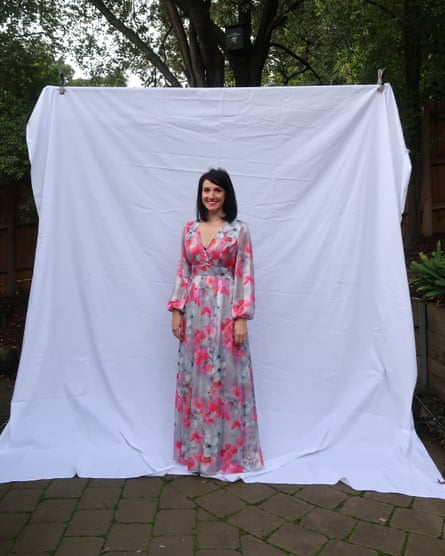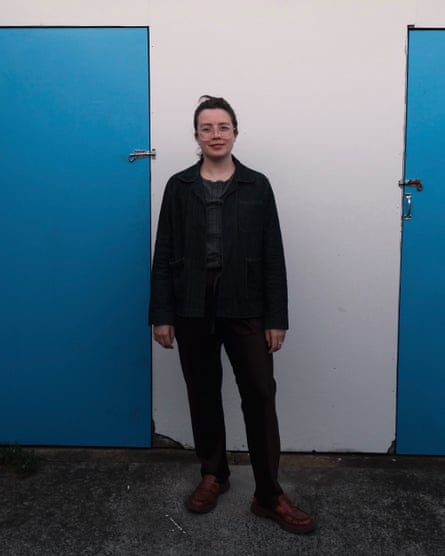
Like many millennials, textiles (a less 1950s name for sewing lessons) was part of the curriculum at my high school. Those classes marked the beginning and end of any attempts to make my own clothes. But I do remember the sense of satisfaction that came with using the overlocker and iron to finish a project: magically turning something crumpled and lumpy into a crisp (if misshapen) garment.
This week, I spoke to four people whose creativity, patience and skillset deepened beyond their early years, allowing them to make their own clothes to this day.
The conscientious objector
The last time Jane Poynter bought an item of clothing was in 2008. Tutored by her mother and grandmother, the Melbourne-based photographer learned to knit and sew before she even started school, so she has always “made a few things”.
But 15 years ago the Rana Plaza disaster and subsequent reports of terrible working conditions in garment factories spurred Poynter into action. Rather than wearing the suffering of others, she decided to make all her clothes herself, from lingerie to outerwear.
She’s found her choices have broadened as a result. “Regardless of what’s in the shops and what’s in fashion, I get to make [clothes] in much better-quality fabric than if I was buying the same item.
“The oldest thing I have in my wardrobe now is a coat I made in a tailoring class about eight years ago. It’s made in Jil Sander deadstock fabric … There were hours of work in it.”
Poynter sources sustainably made natural fabrics online and in retail stores. “A lot of makers say there are two hobbies: sewing and collecting fabric. I do both,” she says. “I have a lot of fabric.
Allow Instagram content?
This article includes content provided by Instagram. We ask for your permission before anything is loaded, as they may be using cookies and other technologies. To view this content, click ‘Allow and continue’.
She spends time experimenting and amending garment patterns, having learned never to expect them to fit “straight out of the packet”. She does this using wearable toiles – a practise garment made using cheaper, plain fabric – and gets creative by mixing two patterns together.
It takes a few drafts before she can get a pattern just right. “I’ve just finished my third pair [of trousers] in dark navy corduroy for winter and the fit is nearly spot on.”
The one-of-a-kind
When Lorenza Hallahan started university in Perth she decided she wanted to improve the basic sewing skills she’d picked up at school. She sought out a sewing teacher in the Yellow Pages then “drove 40 minutes to her house each Tuesday for a two-hour lesson”.
“She introduced me to an overlocker which made my clothes look a lot less homemade,” Hallahan says.
Around the same time, she was going to a lot of electronic dance music gigs. After seeing another woman in the same skirt, she realised how much she valued alternative one-off pieces. “I started to make all my outfits,” she says. “Skirts and tops with flashing lights and battery packs, reflectors, and lots of screen printing and Adidas-style sports jackets for drum and bass gigs.”
“The first piece of clothing I really nailed was an A-line skirt,” she adds. “I made [a version of it] with 137 Pokémon cards sewn on the front.”
Years later Hallahan studied garment construction and invested in her own professional equipment. “No one should be scared of buying or learning industrial equipment or techniques. It makes you a much, much quicker, more efficient seamstress.”
Allow Instagram content?
This article includes content provided by Instagram. We ask for your permission before anything is loaded, as they may be using cookies and other technologies. To view this content, click ‘Allow and continue’.
She describes sewing as a hobby “to get lost in and enjoy outside of your daily grind”, with the bonus of having beautiful garments to wear. “And there’s nothing quite like the feeling when someone asks you: ‘Wow, where did you get that?!’ And you get to casually say: Oh, I made it.”
The thrift stitcher
Isobel Williamson’s love of sewing started with a gift: the sewing machine she received for her 15th birthday. She could make garments well beyond a teenager’s budget.

“I’m always chasing a style, texture or silhouette and often can’t afford to buy the designer clothes I froth over,” says Williamson, who is a marketing coordinator.
With some help from her mother and sister, she refined her skills and learned that sewing requires patience – and more than a bit of forethought.
“Never sew your outfit the night before you need to wear it to a wedding,” she says. “I’ve done this too often and it always ends in tears or with a finger stitched to the bodice.”
People in the sewing community often post finished projects and share details about fabrics on social media, so this is Williamson’s go-to when planning a project. “You can see the finished product on different body types, and with many different fabrics it helps me choose whether a pattern will suit me,” she says. “It’s great because a designer’s pattern photos can look quite different.”
Allow Instagram content?
This article includes content provided by Instagram. We ask for your permission before anything is loaded, as they may be using cookies and other technologies. To view this content, click ‘Allow and continue’.
Since patterns are available online and need to be printed on a large scale, she recommends going to a local print shop to save the hassle of printing at home. But she cautions: “Check they print A0 before you rock up.”
The legacy sewer
Laura Howard, founder of the clothing label Saint, comes from a long line of sewers. “My mother taught me how to sew when I was a child,” she says. “And her mother taught her and her mother taught her!”
Howard was eight years old when she had her first sewing lesson. At 10 she had made her first garment – an asymmetrical silk satin skirt that was “mini in length on one side, open at the thigh and fastened with a single button with a huge section of fabric draping down”.
“I raced downstairs to show my mum and dad what I had made,” she says. “They both thought it was wonderful. I definitely felt the magic in that moment.”
She’s since made a career in fashion, and relishes the freedom of being able to “think up a garment and create it”. But her tastes have moved towards the classics. “The most recent garment I made was a tailored pair of pants in an incredible 100% wool taupe with a wide pinstripe. It was Italian deadstock fabric.”
She only buys vintage patterns, which she finds in op shops. “They are quite brilliant. I have found a lot of styles that are still relevant today.”

